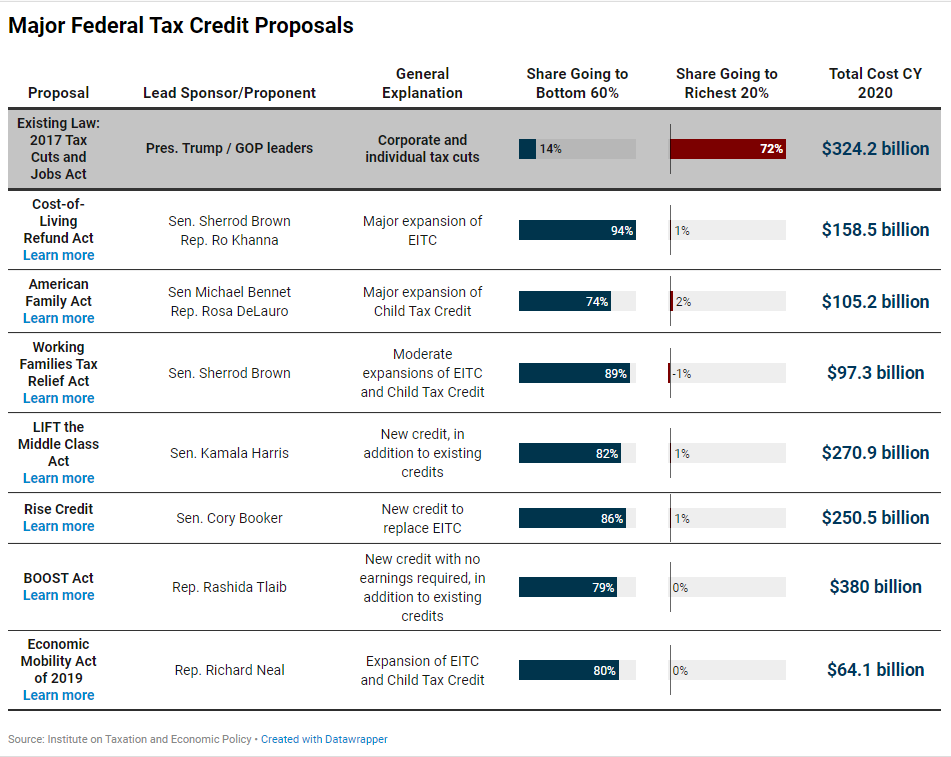The tepid economic recovery is leaving millions behind. The nation still has nearly 10 million fewer jobs than it did in February, according to the latest jobs report. The number of people living in or near poverty is rising. Twelve million workers are about to lose their unemployment insurance, roughly four in 10 people report experiencing food insecurity for the first time, and conditions are likely to deteriorate further in the weeks ahead as we brace for another deadly surge in COVID cases and new or tightened restrictions on business and personal activity.
At this moment, it is vital that lawmakers get cash into the hands of those who need it most.
Temporarily modifying federal and state Earned Income Tax Credits (EITCs) to reflect the realities of our current economy is one important step lawmakers should take. Such a move would provide a vital lifeline to low-wage workers whose incomes have declined or disappeared during this crisis.
The following EITC reforms could be implemented by the federal government, in the states or, better yet, at both levels of government. State lawmakers do not need to wait for federal action to take immediate steps to improve their constituents’ lives.
- At a bare minimum, lawmakers should allow EITC beneficiaries who have seen their income decline take the higher of their 2019 or 2020 EITC amount. Lower-wage earners were more susceptible to job loss during this pandemic. This option would offer some stability in families’ EITC claims by allowing taxpayers to calculate their credit based on a more normal year for earnings (2019). Federal or state lawmakers (in the 29 states, plus D.C. and Puerto Rico, where state-level EITCs exist) could add this backstop to ensure that families whose wages dropped or bottomed out in 2020 or 2021 will receive a credit at least as large as the one they qualified for in 2019. For example, if a single mother of two worked full time, earning the federal minimum wage, in 2019 she would be eligible for the maximum $5,828 federal credit. If she lost her job in April 2020, early in the pandemic, she would only be eligible for a $2,010 credit in 2020. Without this straightforward reform, she and her family would see their EITC benefit plummet by over $3,800 relative to the year before, at a time when that extra cash might make the difference in being able to put food on the table and pay the rent.
This proposal gained momentum at the federal level as part of the HEROES Act, passed by the House in May. That legislation would have allowed filers who saw their earned income decline between 2019 and 2020 to claim an EITC for 2020 based on either their 2019 or 2020 income—whichever would have yielded the greater credit.
- Expand and enhance EITCs for workers without children in the home. While the federal EITC provides a great deal of support for families with children, its impact is limited for those without children. The maximum credit is much smaller and the income limits are more restrictive for these individuals and families.
Childless workers under age 25 and those 65 and older are ineligible for the EITC as it is currently designed. These are workers who are just getting a foothold in the job market or are working well beyond the traditional retirement age.
At the federal level, lawmakers have proposed numerous pieces of legislation to improve the existing EITC, many providing greater benefits to childless adults through boosting the maximum credit, increasing income eligibility limits, and expanding the age cutoffs to include both younger and older childless adults. Improvements at the federal level would have a ripple effect throughout states with EITCs that couple to the federal credit.
Fortunately, states have not taken a backseat while awaiting federal action. Policymakers in California, Maine, and Maryland have expanded their age eligibility to include those 18-24 years old. Minnesota and New Jersey offer their credits to those 21-24 years old. California’s credit is also available to workers 65 and older. The District of Columbia boosted and expanded its credit for childless workers aged 25-64, adding higher income eligibility thresholds and expanding their credit to 100 percent of the federal amount. Maine increased its credit for childless workers to 25 percent, up from the state’s ordinary 12 percent credit.
- Expand EITCs to include immigrants and their families. Immigrants were largely left out of this year’s federal stimulus relief, and they are too often left out of key policies that aim to mitigate poverty. In response to this inequity, Congress and the states can follow the lead of California and Colorado (effective in 2022) in expanding EITC eligibility to include immigrant workers (PDF) who file taxes using Individual Taxpayer Identification Numbers (ITINs). By extending the credit to this group who—based on their work and earnings—should qualify, lawmakers can benefit one of the most vulnerable and hardest hit populations during this recession.
For a longer list of potential reform options visit Adding Flexibility to Make the EITC Work During the Pandemic.
When lawmakers act, it makes a difference.
In March, Congress propped up our fragile economy with an infusion of cash. This federal assistance kept millions of families out of poverty and provided newly unemployed workers a temporary financial lifeline. However, given the duration and depth of this crisis, it’s no secret that the country needs another round of federal stimulus.
Americans are rightly looking to Congress for the support that only our federal government can provide during a crisis such as this. But state lawmakers also have a role to play in improving the lives of tens of millions of low-income Americans who have borne the brunt of the economic damage. They can do this by enhancing their own Earned Income Tax Credits (EITCs) to work better during these unprecedented times when many families have found it difficult or impossible to earn a living and generate the “earned income” that is necessary to qualify for this important program.





